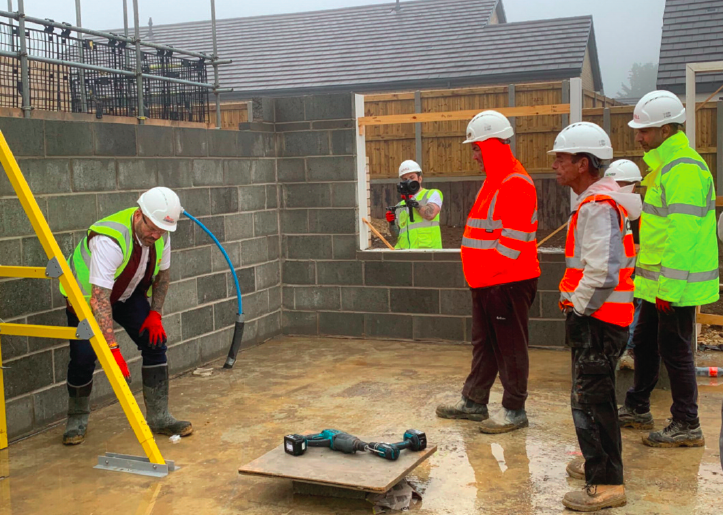
PHPD talks to Carl Harris, Managing Director of Harris Brick Safety Systems, about his Brick Bud System that looks to improve site safety in a big way.
The best products and solutions in the construction industry often come from within. It’s the lived in experience of those who have spent time on the tools that really leads to inventive and practical ideas. Someone who can attest to this is Carl Harris, Managing Director of Harris Brick Safety Systems. Carl started off as an apprentice, moving up to a bricklayer and finding real passion in the profession. It was a few years ago, when an accident led to a wall falling on Carl and doing long-term damage that the idea for the Brick Bud came to him – a reusable engineered GRP frame that transfers weight through to the floor, designed to prop brick walls during construction.
“I had the accident, had numerous operations and had to retire from bricklaying, the job I loved, and changed my career into health and safety and then site management.” Carl recalls. He adds that although the idea came to him when he had his accident, it wasn’t until the COVID pandemic and subsequent lockdown that he really had time to put pen to paper.
The wall that fell on Carl was propped up by a piece of timber. As many housebuilders know, this is pretty standard practice across most of the country, coming under the umbrella term of temporary works. Despite the important role wall propping plays though, Carl tells me that on the sites he visits (and all those he worked on himself in the past), it isn’t really something health and safety inspectors pay too much attention to. For most, it’s as simple as putting something heavy up against the wall and job done. Carl argues more needs to be done, and rightly so given his experience. When meeting him, he showed me a folder full to the brim with pictures on-site where walls have toppled over.
From Carl’s estimations, the UK is losing around 20-23% of walls on site. It’s a figure based on his experience in the trade and time since visiting sites across the country. He states that the major problem with getting an exact figure is a distinct lack in reporting. “When a wall falls, that site manager doesn’t want health and safety involved, the excessive paperwork, the reporting, the insurance premiums rising nor the mark on the site, the list goes on and on. I’ve had plenty of walls fall. I know as a bricklayer for 27 years and a site manager for the last 5 years what actually goes on on-site.”
The idea behind the Brick Bud is to be an engineered solution to the problem. It’s not just an improvised solution based on whatever is lying around, it’s an active step that could prevent injuries, or even casualties, on-site. If a wall does fall and kill a colleague, visitor or even thief on-site, everyone from the principal contractor all the way down to a sub-contractor is liable for prosecution of corporate manslaughter.
Safety isn’t the only advantage to the Brick Bud either, the monetary savings could be huge too. “I know that around 189,000 traditional houses were built in 2023. 23% of that is 43,556 walls. The average cost of a wall is £3,000. Multiplying the two numbers together and it’s over £100,000,000 lost in the walls alone.” Carl explains. The costs, of course, go further than just the walls themselves though. When the labour costs of clearing away the rubble and then rebuilding the wall are factored in, added to the waste removal costs, possible damage to scaffolding or joists below, broken wall ties and damp proof courses and rising insurance premiums – well, it doesn’t paint a pretty picture.
With sustainability at the forefront of the future of construction, this is another draw for the Brick Bud. In fact, Carl was a recipient of the government’s Net Zero Innovation Scheme, which has allowed him to pursue his company, Harris Brick Safety Systems, full time. From Carl’s calculations, 35 million bricks are wasted a year in walls falling (enough to build another 3,000 houses). Then, with a nifty series of further sums, Carl reveals that this amounts to 23,000 tonnes of carbon dioxide emitted just to create the bricks and cement of those wasted walls. This doesn’t even begin to calculate the emissions caused by clean ups and new deliveries.
The Brick Bud officially launched last year and has since received quite the reception. With multiple awards under his belt already, Carl is certainly a busy man and is often out delivering Brick Bud training to housebuilding sites across the country. Being CITB affiliated, these courses extend to colleges too, where Carl teaches courses on all the implications that the Brick Bud resolves. Experts are predicting that gale force winds will increase in their frequency thanks to climate change. Housebuilders are sure to make good use of a support like this that can withstand 72mph winds. Not only could it save a lot of wasted money and hassle, but it might also just save a life too.
For more information on the Brick Bud System visit Harris Brick Safety Systems – Brick Bud.

